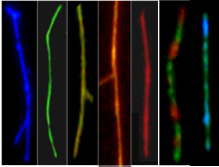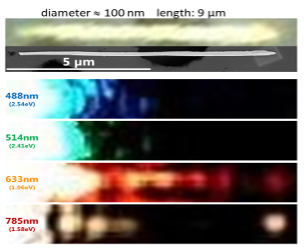-
Share this page
Jean-Luc Duvail
Professor, Université de Nantes

Jean-Luc Duvail received a B.S. in Physics in 1991 and a PhD in Materials Physics under supervision of professor A. Fert (Nobel Prize in Physics, 2007) from University of Orsay Paris-XI, France. He did postdoctoral research with professor L. Piraux at UCL, Belgium, before joining the Faculty at the University of Nantes in 1998.
He is currently professor and Nanowire group leader at the Institut des Matériaux de Nantes Jean Rouxel, France. His research is focused on the design of (multi)functional 1D nanostructures for promoting original physical behaviour in relation with electronics, optoelectronics, plasmonics and nanophotonics. He published 105 articles in international journals and 6 book chapters. He is a member of the steering committee of C’Nano, the French national competency Cluster in Nanoscience (CNRS UAR 2205). He (co)supervises the Master Sciences de la Matière and the Graduate Program Innovative Materials and Energy Systems of Nantes University.
Institut des Matériaux de Nantes Jean Rouxel, Nantes Université - CNRS, France
Keynote: Design of nanowires for tuning and improving nanophotonic and plasmonic properties
There is a tremendous interest in one-dimensional nanostructures, since they permit enhanced properties as well as new paradigms for electronic, optical, optoelectronic, and photonic devices. Besides inorganic systems, polymer-based nanowires and nanotubes are being intensively investigated. Indeed, they allow to design complex architectures by combining different materials at the scale of the characteristic physical lengths in order to control optoelectronic properties, to get enhanced behaviors and ultimately to promote new paradigms for devices. Moreover, the 1D geometry promotes sub-wavelength optical propagation and cavity effects suitable for integrated nanophotonic devices (for a review, see [1]).
In the first part, I will propose an insight in the design of hybrid nanowires and nanotubes combining a polymer matrix with single-wall carbon nanotubes [2] or phosphorescent clusters [3] for tackling some challenges of light-emission and propagation at a sub-micrometric scale (Figure 1).
In the second part, I will present a proof-of-concept of remote Raman sensing for coaxial nanowires [4]. Additionally, a laser-heating strategy has been developed to enhance the in- and out-coupling of light (excitation and emission) with the surface plasmon polaritons propagating along modified gold nanowires [5].

Figure 1 : Optical (fluorescence) microscopy images of polymer-based nanowires
as 1D nanosources and active nanowaveguides.

Figure 2 : Excitation and propagation of surface plasmon polaritons
along gold nanowires at different wavelengths.
[1] A. Garreau, J.L. Duvail Advanced Optical Materials 2, 1122-1140 (2014)
[2] Self-ordering promoted by the nanoconfinement of poly(3-hexylthiophene) and its nanocomposite with single-walled carbon nanotubes. D. Khlaifia, et al. Nanotechnology 30, 055603 (2019)
[3] Efficient active waveguiding properties of polymer nanotubes doped with Mo6 nano-clusters. J. Bigeon, et al. Nanotechnology 27, 255201 (2016)
[4] Coaxial nanowires as plasmon-mediated remote nanosensors. D. Funes-Hernando, et al. Nanoscale 10, 6437-6444 (2018)
[5] Toward Laser-Induced Tuning of Plasmonic Response in High Aspect Ratio Gold Nanostructures. M. Pelaez-Fernandez, et al. Nanophotonics 11, 3719-3728 (2022)
